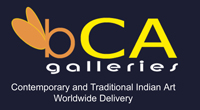Contribute
| South Asian Art: Figurative Vs. Abstract Art – The Eternal Debate |
06/22/2009
Figurative vs. Abstract Art – The Eternal Debate For years there has
been a chasm that has developed between artists who do figurative and abstract
work. Each group stands on its own side considering themselves to be the
superior artists. The figurative artists believe it takes a good eye, technical
skill and precision to duplicate life with all its anomalies and variances on
canvas. The abstractionists beg to differ and claim that abstract work is the
true mark of imagination and intelligence of the artist. If we were to define
the two, figurative work would be simply said to be art that can be easily
identified, for instance even if someone has never heard of the Mona Lisa, by
far one of the most venerated figurative works in history, one could still say
that it was the painting of a woman. In contrast, abstract work looks like
nothing in real life; it could be the artist’s interpretation of an object or
even amorphous shapes and colours which have essentially no meaning at all. In the Indian context,
figurative art has always dominated. The more famous figurative artists like
Raja Ravi Verma and M F Hussain have given us art that is delightful as well as
thought provoking. The Calcutta school of art produces artists who have a
typical leaning towards figurative works. Centuries of creation involving
temples and statues of Gods and Goddesses has left its imprint on the Indian
psyche which continues to prefer art that does not have negative connotations.
Themes like violence find reluctant buyers, who would probably purchase those
for the signature on the canvas, as an investment, and never really display the
works. Abstract art has its
takers and its champions like Laxman Shrestha, Raza and Ravi Mandlik. In fact
there are buyers who perceive a convoluted ‘snob’ value in abstract art. When
abstract art is considered to be ‘intelligent’ the buyer derives pleasure in
knowing that he/she has art that essentially no one understands. Though in
deference to genuine art lovers, this may be a small microcosm of the art
buying fraternity. Figurative artists have
had to struggle to prove their worth in comparison to abstract artists. It is
said that after the invention of the camera, figurative art became redundant.
Some would even say that the camera liberated artists and gave them the freedom
to look within expressing what they felt rather than what they saw. When a
devise could so accurately capture every element of the composition, where was
the need for an artist? However, a gifted figurative artist can bring out
underlying nuances, emotions and even find room for his own personal comment on
the situation that a camera cannot. Today, there is once
again a greater leaning towards figurative art. In the recently concluded
exhibition organized by bCA Galleries in Galleria 919, Pakistan, of the 18
works sold just 1 was abstract. The artist Jumali is famous in the US for his
figurative works. Of course there are
some artists who prefer to tread the middle path and create semi-figurative or
semi-abstract works. There will always be multiple permutations and
combinations in art, one should not need to draw boundaries and borders
disallowing one form to bleed into the other. The essential thing to consider
while appreciating purchasing art is whether you like and understand it, at
least art should be kept pure from the latest ‘fads’. As for the superiority of
figurative over abstract or vice-versa – the debate continues! ~ Razvin Namdarian
You may also access this article through our web-site http://www.lokvani.com/
